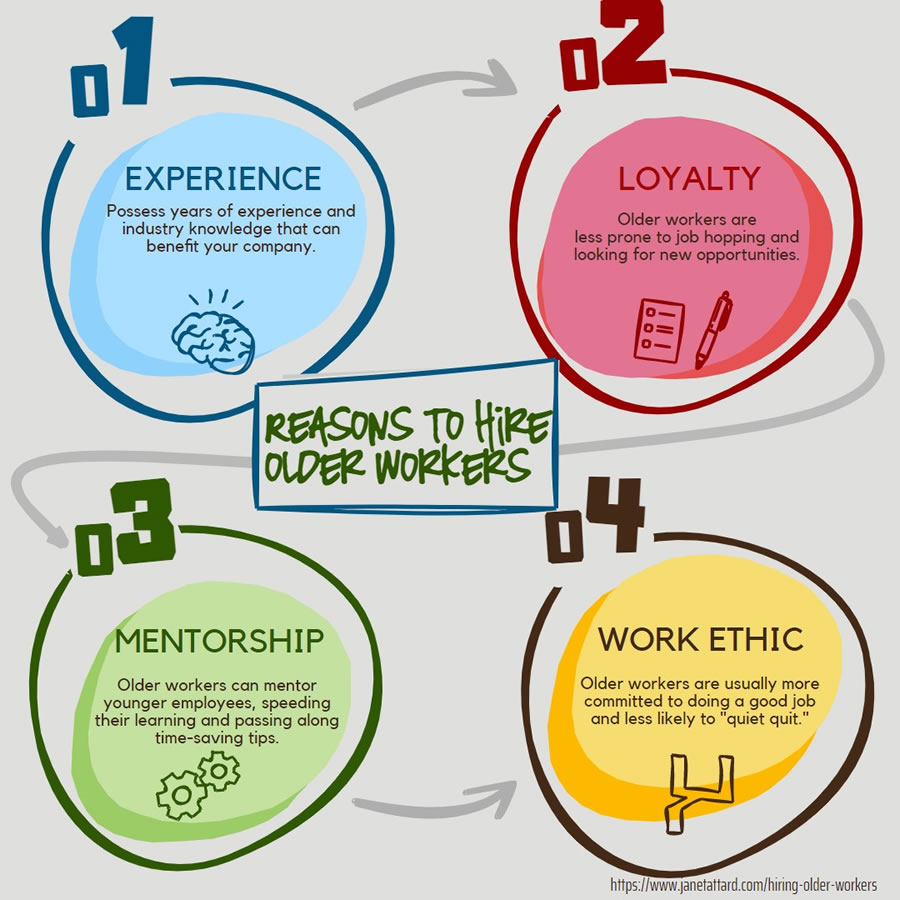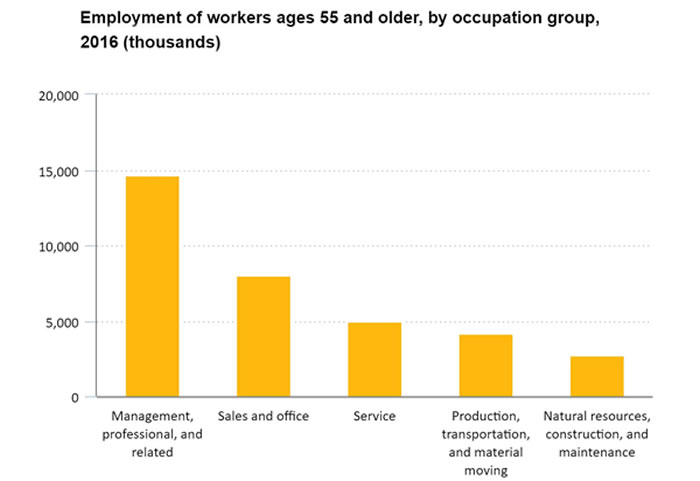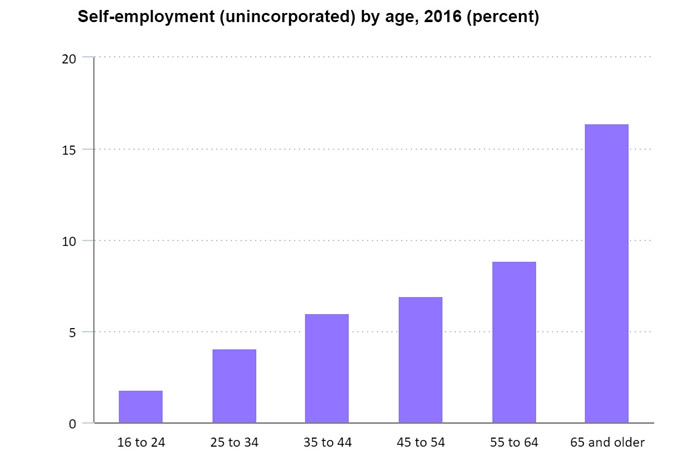Are you having trouble finding good employees for your small business? If so, hiring older workers could be the way to fill your job openings with experienced, loyal employees.
Right now, many industries are experiencing labor shortages. Small and mid-sized businesses can find it particularly difficult to attract employees if they are competing with bigger companies for top talent.
Among the reasons: the labor force has shrunk. The U.S. Chamber of Commerce America Works Data Center reports that there are 1.95 million fewer people in the labor force in Spring, 2023 than there were in 2020.
But while the overall labor pool is smaller, there is one segment workers that is growing: men and women who are 55 and over. According to a U.S. Bureau of Labor Statistics (BLS) published in Career Outlook, the labor force is expected to reach 164 million people by 2024. About 41 million workers (25%) will be aged 55 or older. Of that group, 13 million are expected to be 65 and older.
In fact, 49 percent of Baby Boomer workers expect to work past age 70, according to Post-Pandemic Realities: The Retirement Outlook of the Multigenerational Workforce. The study, published by the Transamerica Center for Retirement Studies® (TCRS) in collaboration with Transamerica Institute® points out that Boomers success at continuing employment depends on “support from employers” and “just two-thirds (66%) say their employers are age-friendly.
Related: Self-employment and microbusiness statistics
The growth in the over-55 workforce isn’t the only reason to consider hiring older workers, however. Mature employees have years of experience and know-how they can put to work for your company and pass down to younger, less experienced employees. Furthermore, older employees are often more loyal and may have connections that could be valuable to your company.
Here’s a look at the advantages, potential challenges, and the myths about hiring older workers.
1. Advantages of Hiring Older Workers
Whether you’re looking to fill a full-time or a part-time position, an older worker can be an excellent choice. Here are some of the ways you can benefit from hiring older workers:

Experience and Knowledge
One significant advantage of employing older workers is their extensive experience in various industries and in life. With years or even decades spent working in different roles and companies, they have likely encountered a wide range of situations and challenges which they’ve successfully navigated, gaining valuable skills, information, and contacts along the way. This accumulated expertise can save your business time and be great asset when it comes to problem-solving, decision-making, or even things like locating or dealing with reliable vendors.
Loyalty and Commitment
Older workers are often more loyal to their employers compared to younger generations, and often take fewer days off. According to a study by AARP Public Policy Institute, workers aged 55+ tend to stay longer at their current employer than those aged 25-34. Younger generations are more prone to changing jobs frequently for new opportunities or better compensation packages. In fact, during the Great Resignation of 2022, people 44 and under were the ones who were most likely to resign. Furthermore, older workers are less likely to be “quiet quitters”. (Quiet quitters are those who do the bare minimum.)
This loyalty translates into lower employee turnover rates for your company – saving you time on recruitment efforts while also reducing recruiting and training costs associated with new hires.
Mentorship Opportunities
- Mentoring Younger Employees: Older workers’ vast experience makes them excellent mentors for less experienced colleagues who could benefit from guidance in navigating professional challenges. This mentorship can help develop a more skilled and knowledgeable workforce.
- Reverse Mentoring: On the other hand, older workers may also benefit from reverse mentoring where younger employees share their expertise in areas such as technology, social media, or other trends that shape the way younger generations shop and buy products and services. This exchange of knowledge promotes an inclusive work environment that fosters growth for all team members.
As these points illustrate, hiring older workers offers numerous advantages to small businesses and startups. Their experience and knowledge can contribute significantly to problem-solving processes while their loyalty helps reduce employee turnover rates. Additionally, they can serve as mentors for younger colleagues – helping create a well-rounded workforce that benefits the company overall.
So, what’s stopping more businesses from hiring people who are 55, 65 or older? In many cases, it’s preconceived notions about age and work.
Myths and Misconceptions About Older Workers
Unfortunately, there are still a lot of false assumptions hiring men and women who are older than most employers envision when they picture a new employee in their mind’s eye. So, here are some facts to debunk some of the common myths about older workers.
Lack of Technology Skills
A common misconception is that older workers lack the necessary technology skills to for today’s digital world. Studies have shown, however, that many older individuals are as proficient as their younger counterparts in using various technologies, software programs, and AI applications. Thus they can be just as tech-savvy as their younger counterparts. Need an example? I was over 70 when I taught myself how to use WordPress to build this site and EmailMarketingIdeas.com.
Unwillingness to Adapt to Change
Another myth is that older employees are resistant to change and unwilling to adapt new methods or ideas within the workplace. But the fact is that many experienced professionals not only possess the capability to adapt to change, but they also enjoy exploring innovative technologies and practices that can enhance their jobs and the companies they work for.
Lower Productivity Levels
A third myth suggests that productivity levels routinely decrease with age due to physical limitations or cognitive decline. But overall, age alone is not a predictor of productivity or cognitive abilities.
Now, it is true that physical limitation can be an issue in occupations that require manual physical labor. But chances are you know one or more GenZ individuals who wouldn’t be very productive at manual physical labor, either. And it is true that some older individuals start to experience cognitive decline as grow older. But not all do. Furthermore, if there are cognitive changes, the age at which they’re likely to begin is 70 and up.
3. Disadvantages of Hiring Mature Workers
Along with being aware of benefits and myths of hiring workers who are older, you also need to be cognizant of potential drawbacks of employing them. Like any business decision, you need to weigh the pros and cons before making a hiring decision. Here are some potential drawbacks to consider:
Higher Salaries and Benefits Costs
One possible disadvantage of hiring older workers for small businesses is that they may command higher salaries due to their extensive experience in the workforce. Additionally, benefits costs such as health insurance premiums may be higher for older employees compared to younger ones as reported by SHRM. While investing in experienced talent can certainly pay off in terms of productivity and knowledge transfer, you do need to assess their budgetary constraints before making a decision.
Potential Health Issues
Another concern is the possibility of increased health issues or physical limitations that could impact job performance or attendance. Age-related health problems might cause some individuals to have more frequent absences or reduce their ability to perform certain tasks effectively.
To address this issue, employers can provide accommodations such as ergonomic office equipment, remote work or flexible working arrangements that allow employees with physical limitations greater comfort while performing their duties. Keep in mind, too, that older workers aren’t the only employees prone to absences from work or physical limitations.
In spite of these potential disadvantages, many small businesses find that the benefits of recruiting older workers far outweigh any challenges they might face.
Here are some ways to create an inclusive workplace culture where employees of all ages thrive together.
4. Common Occupations for Older Workers
People who are 55 and over work in a wide variety of occupations. Their choice depends on their skills and experience, interests, and physical limitations, if any. BLS data shows that 42% of older workers work in management, professional, and related occupations.

Additionally, the report indicates that workers in older age groups have higher rates of self-employment than younger age groups.

Source for both graphs: “Older workers: Labor force trends and career options,” by Mitra Toossi and Elka Torpey, in Career Outlook, U.S. Bureau of Labor Statistics.
5. Strategies for Successfully Recruiting Older Workers
The top “strategy” for successfully hiring older workers is to be aware of any personal biases you have against hiring older workers. Other things you may want to consider include creating an age-inclusive workplace culture, offering flexible working arrangements, and providing training and development opportunities when needed.
Create an Age-Inclusive Workplace Culture
An age-inclusive workplace culture is essential for attracting and retaining older workers in your small business. Foster an atmosphere where all ages are appreciated, valued, and included. Here are some tips on how to create such a culture:
- Promote diversity and inclusion by emphasizing its importance in company values or mission statements.
- Encourage open communication between employees of different generations so they can learn from each other’s experiences.
- Avoid using ageist language or stereotypes when discussing employee performance or potential hires.
- Recognize the achievements of employees regardless of their age group.
Offer Flexible Working Arrangements
To attract experienced older workers who may have unique needs or preferences regarding their work schedule, consider offering flexible working arrangements as part of your hiring strategy. Some examples include:
- Remote work options, allowing employees to perform tasks from home or another location outside the office
- Part-time positions, which can be particularly appealing for those nearing retirement but still wanting to contribute professionally
- Job sharing, where two people share the responsibilities of a single full-time position
- Flexible hours, such as allowing employees to start and end their workday at different times or take longer breaks during the day.
Post Job Openings on Age-Friendly Job sites
While all job sites serve people of all ages, there are several job sites that focus on listing jobs from employers who welcome older workers. Among them:
Provide Training and Development Opportunities
Offering training and development opportunities to all of your employees is a way to keep your company on top of its game. Age doesn’t stop people from wanting to improve their skills and grow professionally. But younger workers may be more likely than older workers to job hop. Here are some training and development ideas:
- Offering workshops on new software programs or industry trends
- Providing access to online courses through platforms like Coursera or Udemy
- Encouraging participation in professional networking events or conferences relevant to their expertise
- Mentoring younger colleagues, which can help both parties learn from each other’s experiences
Incorporating these techniques into your business’s recruitment process can make it simpler to draw in experienced, seasoned staff members and foster an atmosphere of inclusion where all workers may succeed regardless of age.
Frequently Asked Questions About Hiring Older Workers
What are the disadvantages of hiring older workers?
The main disadvantages of hiring older workers include higher salaries and benefits costs, potential health issues, and possible limited mobility or flexibility. However, these drawbacks can be mitigated by creating an age-inclusive workplace culture and offering flexible working arrangements.
Why are companies reluctant to hire older workers?
Companies may be reluctant to hire older workers due to misconceptions about their technology skills, adaptability, and productivity levels. Addressing these myths through education and awareness can help businesses recognize the value that experienced employees bring to the workforce.
Do employers like to hire older workers?
Many employers appreciate the experience, knowledge, loyalty, commitment, and mentorship opportunities that come with hiring older workers. By focusing on these advantages while addressing potential challenges proactively, businesses can create a diverse workforce that benefits from multiple perspectives.
Conclusion
Hiring older workers can bring a wealth of experience and knowledge to any business. By understanding the advantages, dispelling myths, and addressing potential disadvantages businesses can create an effective strategy for hiring older workers that will benefit their organization in the long run. By leveraging the expertise of seasoned professionals, businesses can create a long-term foundation for growth and prosperity.
Take advantage of the experience and wisdom older workers can bring to your small business or startup by hiring them. Investing in an age-diverse workforce is a great way to gain valuable insight and knowledge that could help propel your company forward.
Image sources: Group of workers- Istockphoto; Infograph: created with SketchWow
